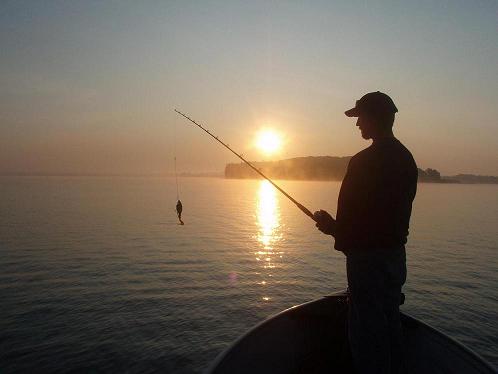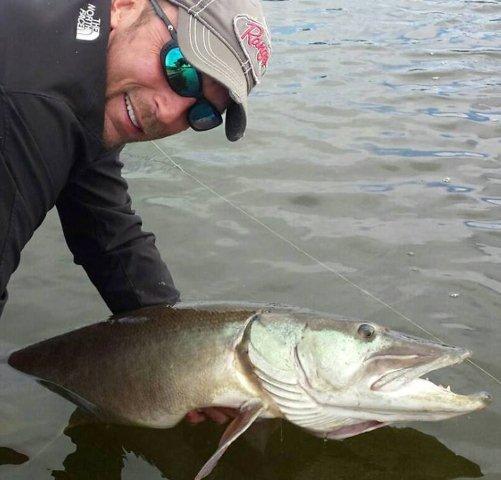|
|
| ok
say you did catch a genetic freak that could qualify for the WR, or for that matter, even a VERY large state record (WI, MN, CANADA, PA, NY...etc..).
find out if the DNR has a way to keep it alive and milk the eggs from it.....the LIVE world record musky...producing offspring for stocking purposes.
i know thats a long shot, it would take an act of God and some REALLY smart and knowledgeable fisheries eimployees to accomplish it....but wouldn't it be cool, and it COULD be done.
if i could accomplish something like that, I MIGHT consider possessing it. problem is, you dont know if it's going to die even IF they're willing to come out and transport the thing in a trout stocking truck or something of that caliber.
it could work though.
my next question, how many of you guys actually keep the state fish contact #'s for your areas in your cellphones. i have them there for general purposes, have for the last 5 years now. | |
| | |

Posts: 32944
Location: Rhinelander, Wisconsin | Problem is, the eggs from that fish may not produce anything but average muskies when stocked in waters across that range, and with the genetic diversity that seems to be coming to light in muskie populations, there is little chance a fisheries manager would rely on that single fish for stocking purposes.
Sorno? | |
| | |

Posts: 2894
Location: Yahara River Chain | "find out if the DNR has a way to keep it alive and milk the eggs from it.....the LIVE world record musky...producing offspring for stocking purposes."
What more do you want? The fish would be something like say 25 years. This fish was spawning for 20 or those years. Do you think that it's eggs are only going produce "genetic freak that could qualify for the WR" when its only at certain lenght? What about the male end? If you mix it with inferior spawn, wouldn't you just "diluting" this as well. Too many variables. You would be money ahead by improving habitat rather than playing match maker. They do just fine without us - and have for hundreds of years. | |
| | |

Posts: 1764
Location: Ogden, Ut | The Yeti - 10/11/2006 10:50 PM
ok
say you did catch a genetic freak that could qualify for the WR, or for that matter, even a VERY large state record (WI, MN, CANADA, PA, NY...etc..).
find out if the DNR has a way to keep it alive and milk the eggs from it.....the LIVE world record musky...producing offspring for stocking purposes.
i know thats a long shot, it would take an act of God and some REALLY smart and knowledgeable fisheries eimployees to accomplish it....but wouldn't it be cool, and it COULD be done.
if i could accomplish something like that, I MIGHT consider possessing it. problem is, you dont know if it's going to die even IF they're willing to come out and transport the thing in a trout stocking truck or something of that caliber.
it could work though.
my next question, how many of you guys actually keep the state fish contact #'s for your areas in your cellphones. i have them there for general purposes, have for the last 5 years now.
Intuitively, it might seem like a good idea (at least from a big fish = more big fish argument), but it doesn't come without it's problems. I'm no geneticist, but have dealt w/ fish long enough to know that it is far more complex that big fish = big fish. The days of simple Mendelian Punnet square genetics are long behind me and I have come to accept the fact that simple 'single gene, single allele' relationships for something like growth are very uncommon in nature. Add to that the problem of only having half of the genetic code (someone already mentioned 'what about the male?'). And the risk of beginning a stocking program based on an individual specimen. Genetic diversity is paramount to the long term existence of a species. It wouldn't be that much of a trick to keep it alive and harvest eggs from it, but it would only be one of many brood fish in the program, that I could guarantee.
What it would give you is a wonderful marketing tool - untapped pretty much in getting poeple interested in and giving support for a program. But as far as any real potential of increasing the overall size of the fish folk encounter...start with a statewide length limit higher than 34". 
S. | |
| | |

Posts: 7100
Location: Northwest Chicago Burbs | Muskie_nut actually brings up a very interesting point, that many of us overlook in our haste to make fish biology somehow the same as human biology: if there exists this super fish, every time it spawns, and has spawned over its 20 years in the lake, it has probably had 100,000 or more eggs fertilized. Chances are, these monster fish arent only finding "genetically INFERIOR" mates each year. My thinking then is that maybe these "super fish" are freaks in ways that genetic coding really isnt a factor.
Example of my thinking: take the fish that Jonesi's client boated, probably between 15 and 20 years old. Has spawned probably 7-9 of those years, right? So, there are probably a few fish swimming in that pond with those "genetics" that are passed on by that fish. However, chances are that fish was "special" in some way, but for some reason the fish that are progeny of this monster fish may or may NOT end What way that is, I personally have NO IDEA, maybe Michael Butler, John Cassleman, or Brian Sloss know what way, but I know that I dont, and none of the arm chair biologists do either. Taking it another step, that fish that was caught has theoretically has ALOT of brothers and sisters swimming in Mille Lacs, however, that fish is "special" in some way because its the biggest that has been caught in possibly 40 years in the state....sooooo? | |
| | |
| Texas has this exact program in place for Largemouth Bass. They've done it for years. I think the Bass must weigh 17lbs or more to qualify. I thought that after a certain point in the fish's life, Bass or Muskie, that they don't spawn as well, or produce the same amount of eggs? Anyone know if that's true? | |
| | |
Posts: 2378
| Slamr - 10/12/2006 8:10 AM
Muskie_nut actually brings up a very interesting point, that many of us overlook in our haste to make fish biology somehow the same as human biology: if there exists this super fish, every time it spawns, and has spawned over its 20 years in the lake, it has probably had 100,000 or more eggs fertilized. Chances are, these monster fish arent only finding "genetically INFERIOR" mates each year. My thinking then is that maybe these "super fish" are freaks in ways that genetic coding really isnt a factor.
Example of my thinking: take the fish that Jonesi's client boated, probably between 15 and 20 years old. Has spawned probably 7-9 of those years, right? So, there are probably a few fish swimming in that pond with those "genetics" that are passed on by that fish. However, chances are that fish was "special" in some way, but for some reason the fish that are progeny of this monster fish may or may NOT end What way that is, I personally have NO IDEA, maybe Michael Butler, John Cassleman, or Brian Sloss know what way, but I know that I dont, and none of the arm chair biologists do either. Taking it another step, that fish that was caught has theoretically has ALOT of brothers and sisters swimming in Mille Lacs, however, that fish is "special" in some way because its the biggest that has been caught in possibly 40 years in the state....sooooo?
dude, did Jonesi type that for you? | |
| | |

Posts: 1243
Location: Musky Tackle Online, MN | On a side note....the fish that Jonesi had in the boat on Friday was very likely about 22 years old. I believe 1984 is the last year that WI strain were stocked there. Just adds to the importance of catch and release. It takes a long time to grow a beast like that!
Aaron | |
| | |
Posts: 1270
| I would hope that if someone caught a legitamite world record they would bop it on it's head and get it offically wieghed, certified, etc. Then we could put an end to all the WR crap!!! | |
| | |
Posts: 638
Location: Bloomington, MN | I thought 16 years was about the maximum known age that muskies live to. They stated in the news article about the 58" out of Nippissing that it was 40 years old. I once read "somewhere" that they netted a spawning female muskie up at or near the Chippewa Flowage (This is not another Hayward promo post!) for numerous years in a row. They once( or still do?)tagged fish in the upper corner of the jaw with a stainless steel V-shaped numbered band. This particular fish over the years peaked at about 40 lbs when it was 49"-50" during spawning, but the remaining 2-3 years the fish was captured its weight continued to drop. This could of course be due to being captured after spawning, but the last recorded length was about 53" and 32 lbs. The fish was never again captured in the nets. 8-10 years after the last recorded capture, an angler using a night crawler briefly has a battle with a large fish that he never saw, but retrieved his hook to find the tag that was from this well documented fish. I really don't know if this is a B.S. story, but does anyone know what the oldest somewhat scientifically documented muskie is? I know that Lake Trout in northern Canada can live to be 40+ years old due to the extremely short growing season due to water temperature, but Sturgeon that reside in the shallow warm water of the Fox/Wolf River chain (Poygan,Winneconne, Butte des Morts) have been documented to reach at least 60 years of age (it might be that prehistortic thing that they got going for them). Wasn't the 48 lber taken out of Round Lake, WI about 9 years ago that was tagged and caught at least 2 times prior to being harvested estimated to be about 12-13 years old? I'm all confused. Dogs and Cats have a tough time making it to 15 years of age, but #*^@ Parrots that no one wants around for more than 15 years, can live to be 100!! If there were an option, I'm sure "WE" would take the "DANGER..NO SWIMMING" signs along the shores of our muskie lakes vs. 7' long bugle mouthed fish being speared through the ice that are smoked and gagged down with a Pabst with their mercury filled eggs spread on a immatation Ritz as an appetizer. | |
| | |
Posts: 177
Location: Lake Forest, Illinois | Steve said: "Problem is, the eggs from that fish may not produce anything but average muskies when stocked in waters across that range..."
while this is indeed true, aren't the ODDS of producing some giant offspring BETTER with this fish, than with an average size fish? Why is it that anytime someone brings this up it is quickly dismissed as almost a bad idea? Is there no middle ground? Would it be so far out of line to suggest that this fish could and indeed should be used for SOME breeding in a way that would potentially pass along the giant genetics without effecting diversity? | |
| | |

Posts: 32944
Location: Rhinelander, Wisconsin | I didn't say if the DNR nets that fish they shouldn't strip her, I simply stated that there's no guarantee that her offspring would be as big, and if placed in waters other than her origin, that they would be anything but average. I look at this from a 'big picture' vantage point, I guess. Point be made here too that if another fish, say a 41, is stripped from that same water and that water is self sustaining, I bet the two fish will be genetically identical. Just a bet, but I'd put a beer on it.
| |
| | |
Posts: 280
Location: Pewaukee WI | Its been proven that there are strains with inferior growth. Its somewhat logical even though some dismiss it here, that if you flip the coin there are fish that have superior growth potential simply due to its genetics. I'm still waiting for someone here to say the fisheries biologist in the South are wrong for only using large bass to collect eggs which they've been doing for years. I'm not saying one side is right for wanting Large Fish and the other wrong for wanting diversity but you can't have it both ways. Only future will prove who is right. In 100 years if the bass in the south are doing great, reproducing well, and growing large, and not infected with the so called "Big Fish Virus" then they were right. If they do have the "Big Bass Virus" then they were wrong. "Virus" being poor reproduction, an actual virus, dieoffs and so on..........
Same holds true for the musky here in the north but we will have no way to tell if we don't use Large fish(Large for there age) for broodstock atleast in some test lakes.
Good discussion. | |
| | |

Posts: 32944
Location: Rhinelander, Wisconsin | Actually, you CAN have it both ways. Diversity and large fish are not opposed, I don't think; in fact I bet most fisheries folks will tell you the opposite. Keep in mind that collecting large spawning bass from the waters stocked is a quite different task than trying to use only large muskies, WAY more of a sample for the bass population. | |
| | |

Posts: 1769
Location: Algonquin, ILL | There's more than just Genetics at work here, Let's assume that the Jonesi fish was in fact a Planted Wisc. Strain then we would also have to assume that other fish with the same Genetics were planted at the same time, if this is true then there should be more fish of this caliber available however to the best of my knowledge none have been caught or reported that were close to that size, Why? Just like Humans Fish are living beings as a living being there are a ton of vairables that affect how a fish lives, acts, responds to stimuli, To understand how this particular fish grew to reach the size that it did you would need to study it's habits as compared to the other fish in the system what was different( Food, Location, Etc.).
| |
| | |
Posts: 177
Location: Lake Forest, Illinois | With the exception of Mill Lacs (and maybe other lakes that I am not aware of that have LL and WI strain ), is it the view of those who believe strongly in diversity over selective breeding, that MN is potentialy doomed, given that they have stocked, for the most part, one pure strain (LL) in their lakes? Also, curious, given the explosion of giant fish being boated on Mil Lacs over the last few years, why the benefits of stocking LL and WI together, has not been discussed. Could some of these recent Mill Lacs giants, not be the result of cross strain breeding? From the pics (in my opinion), one could cetainly argue that they could indeed be. | |
| | |
Posts: 177
Location: Lake Forest, Illinois | John,
You are incorrect about other fish of this size being caught on Mill Lacs. There have been (best of my memory) at least 2 other fish in the last 2 years that have been in the 50+lb catagory. One was on the cover of a MI mag (within th e last year). | |
| | |

Posts: 7100
Location: Northwest Chicago Burbs | If two fish come from the same mother, do they have the same genetics? If those two fish breed, do they then have the same genetics? If one of these fish breeds with a fish with different genetics, what happens to those genetics? If a fish is big, what percentage of its progeny get big? What is the gene for "bigness" in a musky? If a muskie is big, and you mix it with a small fish, how big does the babies get? If two super fish were to breed (ie. fish with "bigness gene") how many of those muskies get to superbigness? Is the bigness gene dominant or recessive? Is the bigness gene related to the "lives long gene"? Is this "bigness gene" a gene just for lenght, or is girth only? Or is the "bigness gene" related to whatever inherintly encoded prediliction towards spawning offshore that some like to point to?
Sean,
If you can answer 1/3 of those with something OTHER than "cause it seems to make sense to me", then you might have reason to rehash all the fights from WinterNet 2005 (which pitted the WMRKPQ against scientists and fisheries biologists), you might not. Otherwise, the reason that people have "all the answers" when you ask the questions is that were asked and answered, and fought over countless times in the WinterNet Fights of 2005. | |
| | |

Posts: 1769
Location: Algonquin, ILL | Sean: I stand corrected about other fish Close to that size as I said " to the best of my knowledge" however I stand by the statement that there is much more than Genetics at work
| |
| | |

Posts: 32944
Location: Rhinelander, Wisconsin | First, define 'pure strain'. I think Dr. Sloss's work will surprise you in the near future. Second, as I understand things the Leech Lake fish were taken from a population, not a select few fish, so the concept of insuring 'diversity' is intact there. The idea is using a representative sample of the population, not just a few or single large specimen from that population, I think. Sorno? | |
| | |

Posts: 1764
Location: Ogden, Ut | sworrall - 10/13/2006 11:51 AM
The idea is using a representative sample of the population, not just a few or single large specimen from that population, I think. Sorno?
yep.
We get pretty caught up in the short term, i.e., '10 years is way too long for a study', when what we need to look at is much longer term. In order to insure survival, a species needs diversity. It helps the populations overcome short-term obsticles (water quality changes, forage availability, predation, etc.). Try to think in terms of what might be in the best interest for the long term survival of the species, not in the best interest for the short term satisfaction of a group of anglers. The same amount of genetic material is available from a 32" fish as a 55" fish, and it may be no less important to the long term survival of the species. We don't know.
There's some threshold numbers of fish from a population (and I don't know what they are right now) needed to 'insure' that organsims from that sample of the population have a good chance of carrying forward all of the necessary genetic material to keep the diversity intact. Conservation genetics - certainly not my field, but probably something anyone really interested in this should look into. Or else just drop it and give Slamr a break.
S. | |
| | |

Posts: 723
| chances are, that fish has already reproduced a handful of times in that water, and those genes are out there, making many more large muskies, but, the fact that anglers still take home 50+ inch fish will never grow record status fish. Here in green bay, we have a 50" size limit. This is great, we catch lots of fish in the upper 40's, year after year, the occasional fish in the 50 mark gets caugth, but, we just dont see the amount of 50's that there should be. Why is this?
cause we get rookies coming out onto the water their first time, or just the weekend warrior that fishes maybe 5 times a year, and they take those 50's home with them.
Its every anglers state assigned right to harvest one fish a day per regulation. I understand this, so, If a trophy is what you want to grow, then maybe the size limits should be upped, ie. canada, st lawrence, niagra river, go to a 55 inch limit. I myself thought the 50 would be good enough out here, but, now that I see guys taking 50's home, its not even close to enough.
C&R has proved beneficial thus far, only due to the higher size limit. Anglers need to understand, its like quality deer management, kill them now, they'll never get big.
We have the genes over here to grow mammoth fish, a 45 incher here pushes 30lbs, we just dont know the exact longevity of these fish, Our dnr biologist Kevin Kapuscinski is leaving us and going to New York due to wisconsin not letting him get his docterate\masters, Not sure which one, but, this guy has poured his heart and soul into the stocking program we have, and has done a #*^@ fine job. The proof is in the pudding.
He would be my guy to call when I have the slob in the net, I would want him there to see his work in progress, or should I say, the finished product, but, hes leaving us, and the dnr has no intention of replacing him right away.
I love reading all this heresay on this board about what would you do if you caught the world record, or what do you consider a superfish. Im still waiting for the controversy to start when someone gets "close" and bonks it, but falls 3lbs short. All he!! is gonna break loose, from a bunch of jealous anglers. Bring on the snowcow!
| |
| | |

Location: Contrarian Island | threads like this baffle me...i don't even bother reading all the posts ...i think most of us just want the scientists/biologists/fisheries managers etc to do what they were taught from all the college and schooling they had and to make the right decisions...i am sure they are doing this to the best of their ability and as funding and programs allow...why are there so many armchair biologists????
someone please go catch a new WR so we can get rid of all the heresay and speculation.....I for one would not be jealous it would at least put an end to all the WR banter that has gone on far too long and much too often...
Edited by MSKY HNR 10/13/2006 1:56 PM
| |
| | |
Posts: 177
Location: Lake Forest, Illinois | Unfortunate that you are losing Kevin Kapuscinski. I only spoke with him a few times, and I have only fished the Bay a handful...he always wanted to know how it went. He is leaving behind one heck of a fishery. | |
| | |

Posts: 32944
Location: Rhinelander, Wisconsin | He is an easy guy to talk to, as well. Wisconsin will miss him, I think. | |
| | |
| Why is kevin leaving? Funds getting cut? Its too bad when the first things to get cut in a budget is natural recources. | |
| | |
Posts: 2361
| To get back to the big fish single fish genetics. There is no reason to suspect that a great big fish will not have superior genetics for growth. If it is genetically controlled we should even expect that this IS the case. However, I do not believe that the 30,000 eggs or so carry the same exact genetic code 30,000 times. Doesn't happen this way. Different eggs carry different genetic coding as do sperm. Ever look at a litter of animals and you will quickly understand this concept. If coding were locked in and dependable all dogs in a litter or from the same mating etc. would have the exact same color pattern(just for a very quick and visible example). Doesn't happen that way. But there is something to be said for breeding big animals for size. It has been repeatedly proven in domestic animals that this can be done. However, often in animals there is inbreeding done to concentrate desirable traits and make them show more strongly and dependably in the offspring. This is often done, while disregarding undesirable traits that also might be concentrated.
To do this scientifically and avoid concentrating undesirable traits, I think we are talking about the big bucks that probably ARE NOT in the DNR budget. I guess I am in favor of using large individuals when available but I would not bet the ranch on the outcomes of this low tech method.
I actually think breeding muskies for size is very attainable goal, but I would not want my DNR spending money on this project, nor would I risk my entire musky production on any such scheme.
Edited by firstsixfeet 10/22/2006 11:46 AM
| |
| | |
| How about in Texas with their share a lunker program, it seems to be working with bass. Any comments on that Dave N. Not being argumentive just curious. thanks | |
| | |
Posts: 2361
| randy t - 10/22/2006 4:15 PM
How about in Texas with their share a lunker program, it seems to be working with bass. Any comments on that Dave N. Not being argumentive just curious. thanks
Here is the share a lunker site, note that there does not seem to be ANY scientific follow up with this program to see if it is actually producing superior fish. Maybe there is a collateral study going on but I didn't see it connected to the official site, which I would expect to see if it existed.
Much todoo and GREAT publicity stunt for Texas, and the town that has the fish tank is probably reaping some economic gains from the program, but...? | |
| | |
Posts: 3518
Location: north central wisconsin | Sean, the MI cover fish was from Vermillion.
The WI strain fish that were stocked into Mill lacs, if memory serves me correctly, came from a very narrow genetic pool, in fact only a few fish. Most, if not all, of the WI strain fish stocked in that lake came from Keleps fish farm. He only has a few fish in his private ponds that he strips. Did any WI fish come from any other hatcheries? It would be interesting if Dr. Sloss could sample a few of Mr. Kaleps fish to determine their 'purity' and origin(if that is in fact possible). I beleive that Mr. Kalep got his brooders from LCO many years ago. Interesting to note the success that certain lakes in WI have had growing large fish over the years, that were stocked with fish received from his farm. Again, not sure if just coincidence, but an interesting observation that some of us have enjoyed over the years. | |
| | |

Posts: 32944
Location: Rhinelander, Wisconsin | Mr. Neuswanger covered this in detail some time ago. Also, interestingly, Dr. Sloss's work to date on the LCO fish indicates no significant difference in the fish past and present. | |
| | |
Posts: 3518
Location: north central wisconsin | So does that mean he did sample some of Kaleps fish? I'll try to get in touch with Doc Sloss. | |
| |
|
 a different twist
a different twist a different twist
a different twist